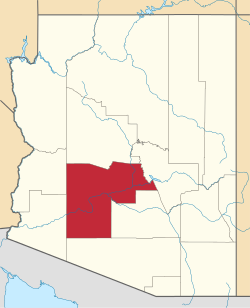Gilbert, Arizona | |
|---|---|
 Gilbert's Heritage Court as viewed from Gilbert Road | |
| Motto(s): "Gilbert: Clean, Safe, Vibrant" | |
 Location in Maricopa County, Arizona | |
| Coordinates: 33°21′10″N111°47′20″W / 33.35278°N 111.78889°W | |
| Country | United States |
| State | Arizona |
| County | Maricopa |
| Founded | 1891 |
| Incorporated | July 6, 1920 |
| Named after | Robert Gilbert |
| Government | |
| • Mayor [1] | Scott Anderson |
| Area | |
• Total | 68.86 sq mi (178.35 km2) |
| • Land | 68.66 sq mi (177.84 km2) |
| • Water | 0.20 sq mi (0.53 km2) |
| Elevation | 1,237 ft (377 m) |
| Population | |
• Total | 267,918 |
| 275,346 | |
| • Rank | US: 76th AZ: 5th |
| • Density | 4,010/sq mi (1,549/km2) |
| Time zone | UTC–7 (Mountain (MST) (no DST)) |
| ZIP Codes | 85233, 85234, 85295, 85296, 85297, 85298, 85299 |
| Area code | 480 |
| FIPS code | 04-27400 |
| GNIS feature ID | 0005032 [3] |
| Sales tax | 7.8% [6] |
| Website | gilbertaz.gov |
Gilbert is a town in Maricopa County, Arizona, United States. Located southeast of Phoenix, Gilbert is home to 293,630 residents. [7] It is the fourth-most populous municipality in Arizona and is considered a suburb of Phoenix. [8]
Contents
- History
- Geography
- Climate
- Demographics
- 2020 census
- 2010 census
- Religion
- Economy
- Largest employers
- Arts and culture
- 9/11 Memorial
- Historic place
- Parks and recreation
- Government
- Mayors of Gilbert
- Education
- Infrastructure
- Transportation
- Health care
- Public Safety
- Notable people
- Sister cities
- References
- External links
Incorporated on July 6, 1920, Gilbert was once known as the "Hay Shipping Capital of the World". [9]








